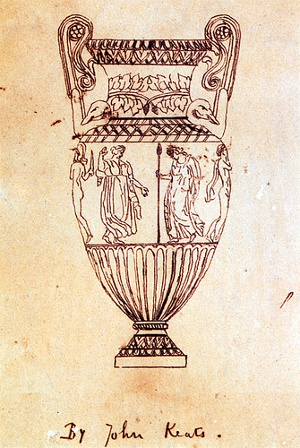John Keats, selected poems Contents
Ode on a Grecian Urn: Synopsis and commentary
Synopsis on Ode on a Grecian Urn
 The speaker addresses an imaginary ancient Greek urn (a vase with a rounded body and narrower neck), commenting on the figures depicted in sculptured relief or painted on it, in a variety of scenes:
The speaker addresses an imaginary ancient Greek urn (a vase with a rounded body and narrower neck), commenting on the figures depicted in sculptured relief or painted on it, in a variety of scenes:- He wonders what stories inspired the men, young girls and gods chasing each other and who the figures might be
- The speaker sees a piper and two lovers. He delights in the fact that he cannot hear the tune that the piper is playing because imagined melodies are sweeter. He consoles the frozen lovers that even though their love cannot be consummated, it will never fade, just as the trees under which they play will never lose their leaves
- He sees a priest leading a heifer to be sacrificed, followed by a procession, and wonders what small town has been emptied of its people - frozen in time, it will be empty for all eternity.
This sad thought brings the speaker back to himself and causes him to remember that when he and all those of his generation have died, the urn will still be there communicating its eternal message to all who contemplate it in the future: ‘Beauty is truth, truth beauty.’
Commentary on Ode on a Grecian Urn
No one knows if, when he wrote this in May 1819 (his great year of productivity), Keats had in mind one particular urn, although it is known that he drew or traced a vase contained in a volume of engravings called Musée Napoléon that he saw in the house of his friend Benjamin Haydon. No doubt Keats’ frequent visits to the British Museum will have provided plenty of other examples. The heifer being led to sacrifice in the poem’s fourth stanza is probably based on an image found on the South Frieze of the Elgin Marbles.
Keats realised that the function of a Grecian urn was to preserve the ashes of the dead. As he wrote in Endymion, ‘Why, I have shed / An urn of tears, as though thou wert cold-dead’. The stasis and tranquillity of the urn is starkly juxtaposed with current human frailty. Having witnessed the death of his brother Tom from tuberculosis a few months previously, Keats was now succumbing to the same illness, so would be familiar with the effect – and consequence – of ‘A burning forehead, and a parching tongue.’ (l.30)
Glossary
still unravished bride: The unbroken urn is still intact, like a virgin.
foster-child: The urn’s creator is dead; therefore, it has been cared for by time and silence.
Sylvan: associated with woods, forests
historian: The urn chronicles a series of events through the pictures which adorn it.
Tempe: a valley in ancient Greece famous for its beautiful woodlands
Arcady: Arcadia, a mountainous region and the centre of the Peloponnese. The people were largely shepherds and goatherds; Pan was a local god. Arcadia became the name for an idyllic land of poetic shepherds.
loth: reluctant
mad pursuit: wild, excited pursuit. Frenzied sexual chases were associated with the ritual worship of the god of wine, Bacchus (Dionysus in Greek). They were commonly depicted on vases.
ditties of no tone: songs which cannot be heard by the human ear
Attic: refers to the city of Athens and therefore to the balanced, symmetrical style of ancient Greece
brede: an interwoven (braided) decorative border
overwrought: painted or carved on the surface
Pastoral: a story concerned with shepherds and their lifestyle, in particular the idyllic country life of Arcadian shepherds
When old age…waste: when everyone now living has died.
Investigating commentary on Ode on a Grecian Urn
- In what way does knowledge of the biographical context of Keats’ life help to illuminate this poem?
- How does knowing about Keats’ literary/artistic background help you understand the poem?
- What impact do the nature and range of cultural references (see the glossed notes) have on you?
- After reading Keats’ other Odes, compare this poem with them and create a table listing:
- The similarities
- The differences.
Wild centre of the Peloponnese, a pastoral ideal.
A pastoral god, Hermes' son, who was partly man and partly goat.
Roman god of wine. (Greek name, Dionysus.)
Recently Viewed
Related material
Scan and go
Scan on your mobile for direct link.